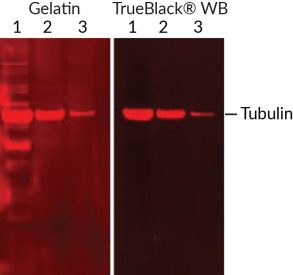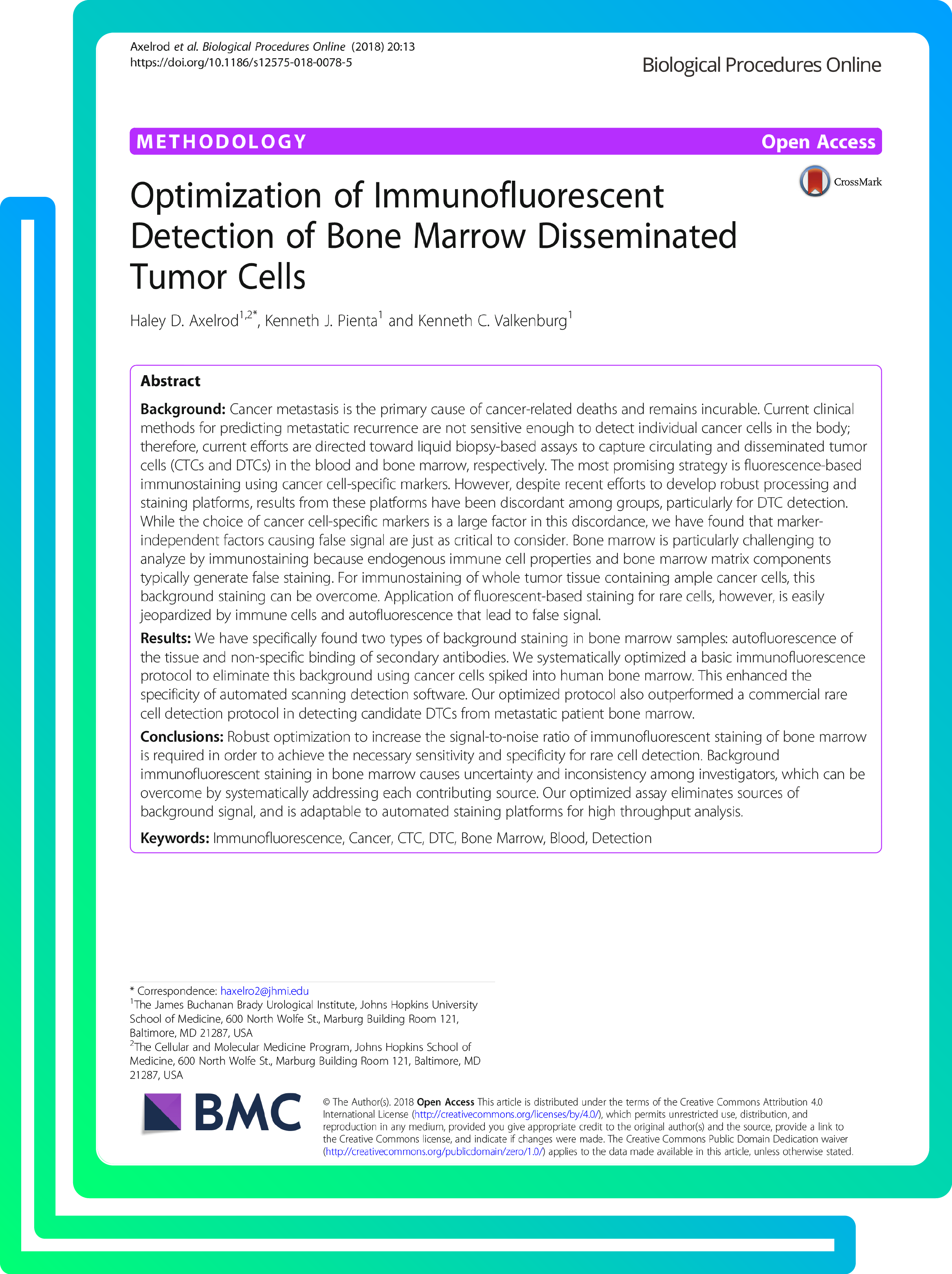TrueBlack® Lipofuscin Autofluorescence Quenchers
Lipofuscin can make fluorescence imaging of human tissues virtually impossible
Lipofuscin consists of highly autofluorescent granules of oxidized proteins and lipids that build up in the lysosomes of aging cells in a variety of tissues. Lipofuscin granules fluoresce brightly in all channels used for fluorescence microscopy (Figure 1). Consequently, immunofluorescence in many human tissues or aged animal tissues can be virtually impossible unless lipofuscin fluorescence is masked.
TrueBlack® eliminates lipofuscin autofluorescence, clearing the way for immunofluorescence
Traditionally, Sudan Black B has been used to quench lipofuscin autofluorescence by incubating tissue sections with the dye after immunofluorescence staining. However, Sudan Black B also introduces non-specific red and far-red fluorescence, limiting the use of fluorescent dyes in those wavelengths. Biotium developed TrueBlack® Lipofuscin Autofluorescence Quencher as a superior alternative to Sudan Black B to quench autofluorescence with much lower background.
TrueBlack® Lipofuscin Autofluorescence Quencher Features
- Eliminates lipofuscin autofluorescence
- Reduces autofluorescence from non-lipofuscin sources
- Doesn’t cause high background, unlike Sudan Black B
- Can be used before or after immunofluorescence staining
- Clears the way for fluorescence imaging of human and aged animal tissues
TrueBlack® treatment can be performed before or after immunostaining (Figures 2-3). It is rapid, simple, and has minimal effect on signal from fluorescent antibodies or nuclear dyes, thus preserving specific staining. Quenching is stable and compatible with commonly used wet-set and hardset fluorescence mounting media, so slides can be stored after staining. See TrueBlack® FAQs for more information.
TrueBlack® reduces autofluorescence from other sources too
TrueBlack® effectively eliminates lipofuscin autofluorescence in tissues like human brain and retina. TrueBlack® also can reduce autofluorescence from other sources, such as collagen, elastin, and red blood cells (Figures 4-5). It is not as effective at quenching these sources of autofluorescence as it is for lipofuscin, but it can improve background in human and non-human tissue types. It also has been used to quench fluorescence on polycarbonate filters used as cell supports for imaging (Futia et al. 2016). Download a list of TrueBlack® references.
TrueBlack® eliminates lipofuscin fluorescence with less background than Sudan Black B

TrueBlack® autofluorescence quencher can be used before or after antibody staining
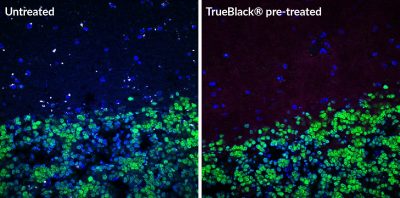
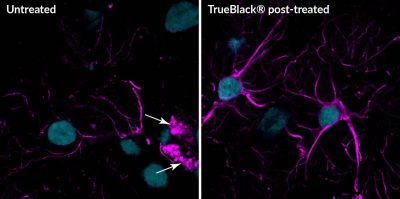
TrueBlack® quencher can reduce autofluorescence from multiple sources

TrueBlack® is widely published for reducing lipofuscin autofluorescence in several human and animal tissues.
Highlighted Citation: In a publication in Biological Procedures Online, Axelrod et al. applied TrueBlack® Lipofuscin Autofluorescence Quencher to enhance imaging of circulating tumor cells (CTCs) in blood and disseminated tumor cells (DTCs) in bone marrow, allowing multiplex target detection and cell morphology analysis of extremely rare cells.
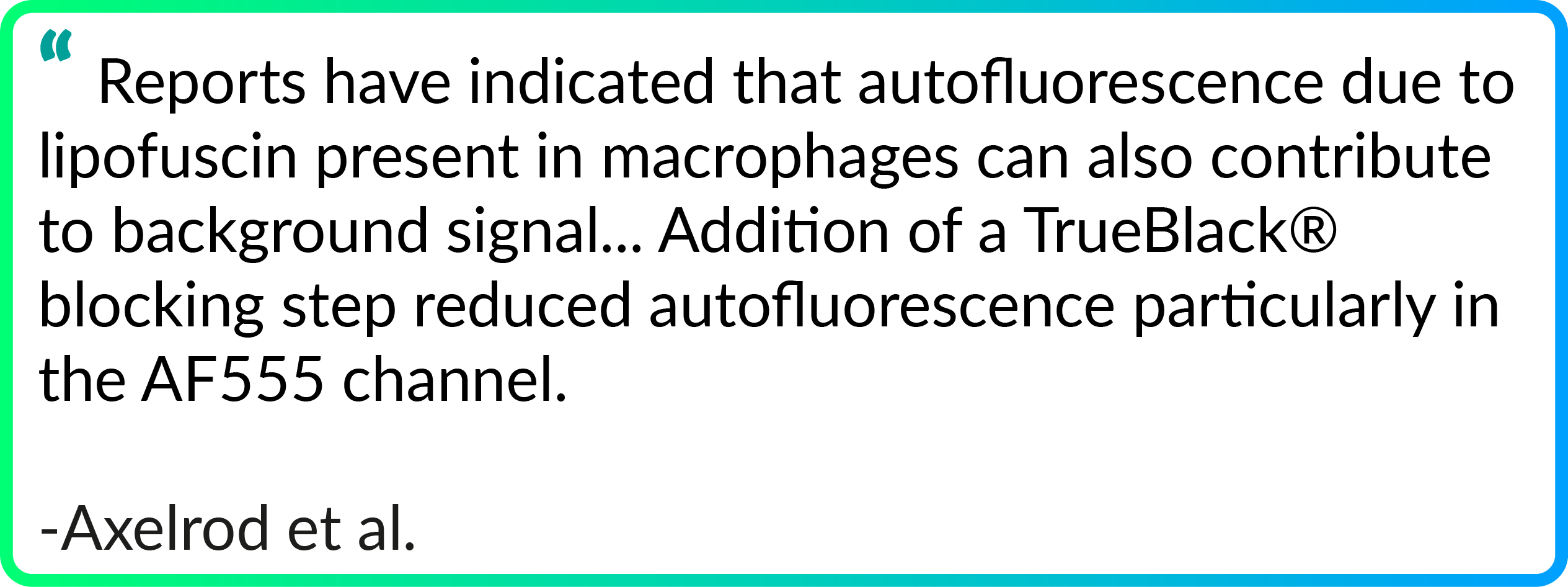

TrueBlack® Plus: A unique lipofuscin quencher
TrueBlack® Plus is a next-generation lipofuscin quencher developed by Biotium chemists. This new quencher was designed to allow lipofuscin quenching in aqueous buffer with even lower background than the original TrueBlack®. Quenching in PBS allows longer incubation times for thick samples without shrinkage, and is compatible with hydrophobic stains.
TrueBlack® Plus Lipofuscin Autofluorescence Quencher Features
- Quenches lipofuscin with lower far-red background than our original TrueBlack®
- The only lipofuscin quencher that can be used in aqueous buffer instead of 70% EtOH
- Reduces autofluorescence from non-lipofuscin sources
- Lower background than traditional Sudan Black B treatment
- Fast and simple treatment before or after immunostaining
- Stable quenching, compatible with commonly used fluorescence mounting media
- Clears the way for multi-color imaging in human tissue
TrueBlack® Plus Quenches lipofuscin with lower far-red background than our original TrueBlack®
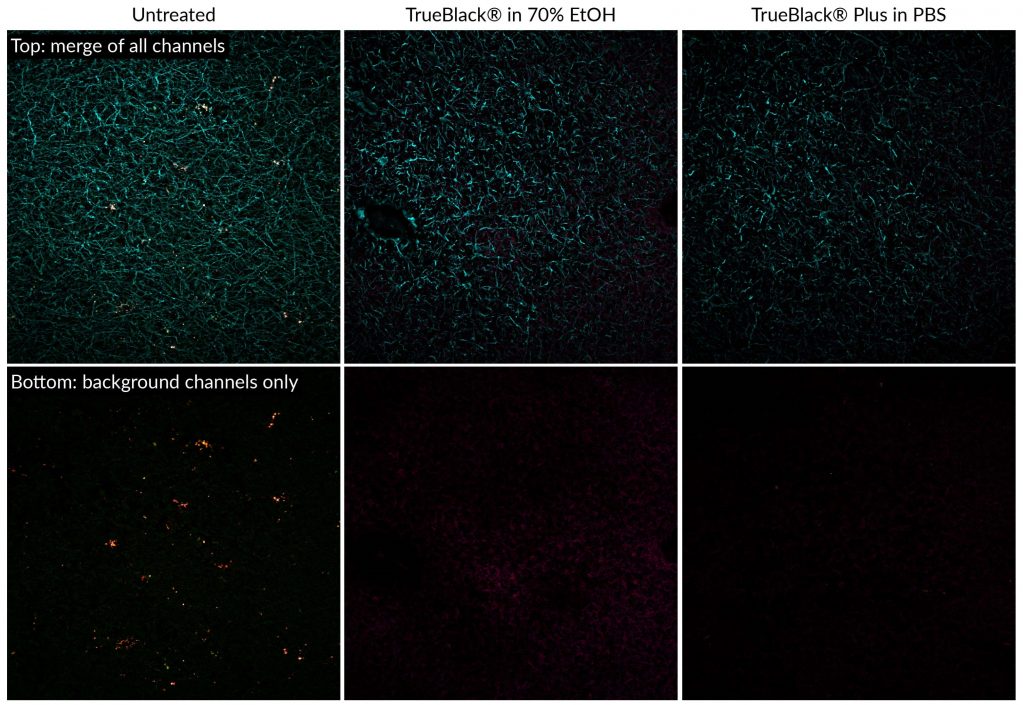
Choose the right quencher for your application
Comparison of original TrueBlack® Lipofuscin Autofluorescence Quencher and TrueBlack® Plus
| Product | Catalog no. | Supplied as | Pros | Cons |
|---|---|---|---|---|
| TrueBlack® Lipofuscin Autofluorescence Quencher | 23007 | 20X in DMF | • Complete quenching of lipofuscin autofluorescence • Ultra-low background in blue and green channels • Quenching takes only 30 seconds |
• Introduces some red/far-red background • Quenching must be done in 70% EtOH • Some quenching of fluorescent dyes |
| 23011 | 30X in DMSO | |||
| TrueBlack® Plus Lipofuscin Autofluorescence Quencher | 23014 | 40X in DMSO | • Greatly reduces lipofuscin autofluorescence • Has lower red/far-red background than the original TrueBlack® • The only lipofuscin quencher that can be used in PBS and other aqueous buffers |
• Titration recommended for optimal quenching • May not be as effective as the original TrueBlack® for high-lipofuscin samples • Some quenching of fluorescent dyes |
VIEW & PURCHASE
EverBrite TrueBlack® Hardset Mounting Medium
All-in-one mounting medium that quenches lipofuscin background, preserves fluorescence signal, and counterstains
Lipofuscin are autofluorescent granules that are a common source of background that make fluorescence imaging virtually impossible in human and aged animal tissues such as brain and retina. EverBrite TrueBlack® Hardset Mounting Medium is the only mounting medium optimally formulated for quenching lipofuscin fluorescence while offering the same protection against photobleaching as our original EverBrite™ Hardset. The mounting medium is available without nuclear stain, with DAPI, or with NucSpot® 640 nuclear counterstains.
EverBrite TrueBlack® Hardset Mounting Medium Features
- The only mounting medium with autofluorescence quenching
- Quenches as it hardens, with low background fluorescence
- Optimally formulated for protecting CF® dyes and other dyes from photobleaching
- Refractive index well-matched to coverglass (1.46 after curing)
- Choice of DAPI, NucSpot® 640, or without nuclear counterstain

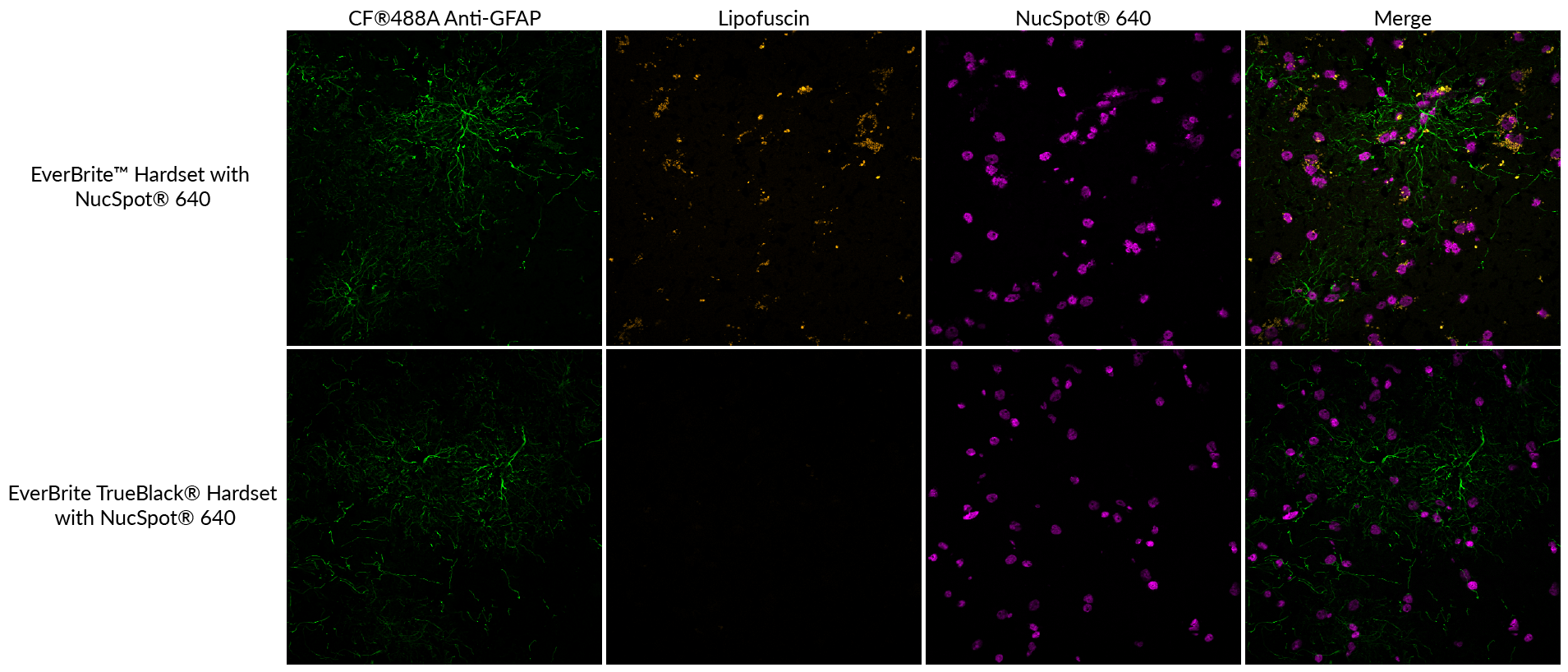
TrueBlack® IF Background Suppressor System
The TrueBlack® Background Suppressor System is a buffer system designed for optimal blocking of non-specific staining for immunofluorescence (IF). The buffers are designed to block background from both non-specific antibody binding as well as direct interaction of fluorescent dyes on antibodies with cells or tissue sections.
TrueBlack® IF Background Suppressor Features
- Suppresses background from non-specific antibody binding and charged fluorescent dyes
- More efficient than Image-iT® FX, block & permeabilize in just 10 minutes
- Complete system for blocking, permeabilizing, and antibody dilution
- Non-mammalian blocking agents, for broad secondary antibody compatibility
- For immunofluorescence on cells or tissue sections
VIEW & PURCHASE
Charged dyes can contribute to antibody background
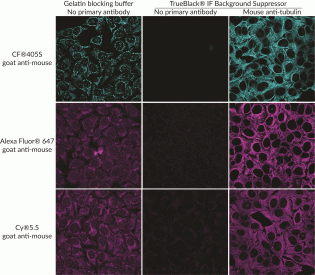
Fluorescent dyes can be an unexpected cause of non-specific antibody binding
Non-specific signal in immunofluorescence can arise from multiple sources, including antibody cross-reactivity with off-target proteins, non-specific antibody adsorption to the sample, and tissue autofluorescence. Another cause of background that is not widely known is the effect of fluorescent dyes themselves on the antibody specificity. Next-generation fluorescent dyes like Alexa Fluor® or CF® dyes often carry multiple negative charges to improve dye solubility and brightness of conjugates. However, the extra charge carried by the dye can result in non-specific antibody binding that can reduce the signal-to-noise ratio of immunostaining, particularly for low abundance targets. While conventional blocking agents like BSA or gelatin can reduce non-specific protein binding, they don’t block background from charged dyes (Figure 1).
TrueBlack® Background Suppressing System blocks multiple sources of antibody background
TrueBlack® Background Suppressor includes reagents for blocking both non-specific protein binding as well as background from charged dyes. Examples of charged dyes that show improved signal to noise with the Background Suppressor are CF®405S, CF®405M, CF®555, Alexa Fluor® 647, and Cy®5.5 (Figures 1-3). One-step blocking and permeabilization takes only 10 minutes, and the buffers contain no mammalian proteins, for broad antibody compatibility.
Excellent blocking for Mix-n-Stain™ labeled antibodies

TrueBlack® Background Suppressor is as effective as Image-iT® FX
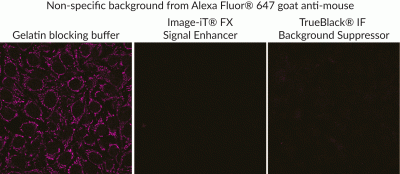
For immunofluorescence blocking of cells or tissue sections
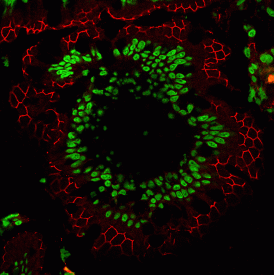
VIEW & PURCHASE
TrueBlack® WB Blocking Buffer Kit
The TrueBlack® WB Blocking Buffer Kit is a ready-to-use buffer system for fluorescence-based western blotting (WB). The buffers yield optimal specificity and sensitivity by blocking non-specific interactions of dye-labeled antibodies with proteins and the blotting membrane.
TrueBlack® WB Blocking Buffer Kit Features
- Blocks as well or better than Odyssey® Blocking Buffer, at a lower price
- Reduces non-specific protein bands and background over entire membrane
- Suppresses background from charged dyes better than BSA, gelatin, or casein
- Compatible with PVDF and nitrocellulose membranes
- Contains no mammalian proteins, for broad antibody compatibility
- For visible and near-IR fluorescent westerns

Superior western blocking for next-generation fluorescent dyes
Non-specific signal in WB can arise from multiple sources, including antibody cross-reactivity with off-target proteins, non-specific antibody adsorption to the membrane, and membrane autofluorescence. Another potential cause of background is the effect of fluorescent dyes themselves on the specificity of labeled antibodies. Highly charged dyes like Alexa Fluor® or CF® dyes have improved solubility and brightness of conjugates compared to uncharged dyes. However, the extra charge carried by antibodies labeled with these dyes can result in non-specific binding to proteins and membranes. The TrueBlack® WB Blocking Buffer Kit blocks background from multiple sources including charged dye conjugates (Figure 2). TrueBlack® blocking buffer is especially advantageous for phosphoprotein detection, significantly improving specificity compared to conventional blocking buffers (Figure 1).
Switch from Odyssey® Blocking Buffer and save
TrueBlack® WB Blocking Buffer performs as well or better for fluorescent WB compared to LI-COR’s Odyssey® Blocking Buffer (Figure 1), and is priced lower on a per membrane basis.
Compare TrueBlack® WB Blocking Buffer Kit with Odyssey® Blocking Buffer
| Product | TrueBlack® WB Blocking Buffer Kit |
Odyssey® Blocking Buffer |
|---|---|---|
| Trial Size | For 10 membranes | 125 mL for 4 membranes |
| Full Size | For 50 membranes | 500 mL for 16 membranes |
